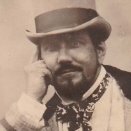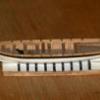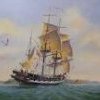MORE HANDBOOKS ARE ON THEIR WAY! We will let you know when they get here.
×

Roger Pellett
-
Posts
4,519 -
Joined
-
Last visited
Reputation Activity
-
 Roger Pellett got a reaction from druxey in The San Marco mosaic ship c. 1150 by Louie da fly - FINISHED - 1:75
Roger Pellett got a reaction from druxey in The San Marco mosaic ship c. 1150 by Louie da fly - FINISHED - 1:75
A trite expression: “you can’t prove a negative.”
Fundamental geometric relationships have not changed since ancient times. Venetian shipyards were not outfitted with “Plank-O-Matic” machines that allowed them to defy Euclid’s laws. If the shape of your hull requires a stealer or drop strake it’s a reasonable assumption that the Venetians required ones too.
Roger
-
 Roger Pellett reacted to ted99 in USS Enterprise (CV-6) by ted99 - Trumpeter - 1:200 - PLASTIC
Roger Pellett reacted to ted99 in USS Enterprise (CV-6) by ted99 - Trumpeter - 1:200 - PLASTIC
Next section aft of the island in place. Used the aft elevator as the "anchor" placement for the decking. As expected, I had to add a single board to make up for the board I had to take out of the first section forward of the island, because the place I had indexed to for the center section of decking was "one board" too far aft. This says to me that if I had started with either the midships elevator piece, or the aft elevator piece as the first piece of decking installed, all the subsequent deck pieces would have gone into place exactly as designed. I'm modeling with the midships elevator in the lowered position. Hence, the missing mid elevator platform.
Construction techniques as before. So far, the PE pieces around the perimeter of the decking have gone into place as designed.
-
 Roger Pellett reacted to Louie da fly in RMS Titanic by Louie da fly - FINISHED - ~1:700 - solid-hull waterline model - my first commission
Roger Pellett reacted to Louie da fly in RMS Titanic by Louie da fly - FINISHED - ~1:700 - solid-hull waterline model - my first commission
This thing is really doing my head in. Oh, for simple mediaeval models with only one or two decks visible! I'm still trying to reconcile the deck plans with how everything is configured in three dimensions, and it doesn't help that the plans I have don't agree with each other, or that due to inaccuracies in the printing process the deck plans in a given drawing don't line up with each other properly (sigh).
Anyhow, I'm still continuing with the two versions - the first one is definitely wrong (for a given level of 'wrong'), but should be able to be completed and sold separately from the one I was commissioned to make. It's all solid. The other (foreground) will show the promenade decks, which need to be made separately and added as separate (very thin) layers. The line of dark wood at the top of this one will be hidden by layers above it, so I'm not bothered about it.
Here they are with what I'd fondly supposed was the superstructure above the boat deck (top deck) but now turns out to be the First Class promenade deck. I've just discovered that the boat deck is yet another deck at the top I hadn't realised existed, and which I now have to make, along with its superstructure.
First ("solid") version.
Second ("decked") version.
I've been trying to keep the promenade decks as thin as possible so the ship doesn't get too tall, but as you can see, there's a limit to how thin they can be made - one of them now has a 'wave' in it and will need to be replaced with a new one. These are of course dry fitted. I'm not going to use glue until I'm much more sure I've got it right.
Nonetheless, I'm (slowly) making progress in getting it all sorted out. All good. She'll be right. But I have yet to figure out how to make the pierced "bulwarks" that run along the edges of the promenade decks.
Steven
-
 Roger Pellett got a reaction from tom q vaxy in mini table saw
Roger Pellett got a reaction from tom q vaxy in mini table saw
I have a Byrnes Saw bought shortly after they first became available, so it’s an old timer. My interests include scratch building of warships’ boats and completing a very long term project; a steel hulled Great Lakes Steamship. I do not anticipate building a classic POF sailing warship model.
Never less I continue to find new applications for my Saw that were totally unanticipated when I bought it: cutting sheet brass and thin craft plywood, cutting dimensioned grooves in jigs to hold parts to be soldered, and most recently slicing off dozens of 1/32in thick hatch boards from a laminated stack. The saw also did a great job of cutting a tapered blank for the mast of a Longboat model.
While many of these jobs could be performed by a milling machine, they’re expensive too, and setup is often more difficult. In addition to its rigidity that allows accurate square cuts, the saw’s versatility is due to two features; the ability to raise and lower the blade and the 1/2in arbor that permits metal slotting blades of various widths. I have never needed a tilting arbor ( which the saw doesn’t have), the extended fence, or the crosscut sled. I did make a sled from a piece of aluminum angle, with an adjustable stop that fastens to the saw’s Standard miter gage.
It’s a shame that high shipping costs, customs duties, etc. limit access to this remarkable piece of equipment to those living outside of the USA.
Roger
-
 Roger Pellett got a reaction from Canute in mini table saw
Roger Pellett got a reaction from Canute in mini table saw
I have a Byrnes Saw bought shortly after they first became available, so it’s an old timer. My interests include scratch building of warships’ boats and completing a very long term project; a steel hulled Great Lakes Steamship. I do not anticipate building a classic POF sailing warship model.
Never less I continue to find new applications for my Saw that were totally unanticipated when I bought it: cutting sheet brass and thin craft plywood, cutting dimensioned grooves in jigs to hold parts to be soldered, and most recently slicing off dozens of 1/32in thick hatch boards from a laminated stack. The saw also did a great job of cutting a tapered blank for the mast of a Longboat model.
While many of these jobs could be performed by a milling machine, they’re expensive too, and setup is often more difficult. In addition to its rigidity that allows accurate square cuts, the saw’s versatility is due to two features; the ability to raise and lower the blade and the 1/2in arbor that permits metal slotting blades of various widths. I have never needed a tilting arbor ( which the saw doesn’t have), the extended fence, or the crosscut sled. I did make a sled from a piece of aluminum angle, with an adjustable stop that fastens to the saw’s Standard miter gage.
It’s a shame that high shipping costs, customs duties, etc. limit access to this remarkable piece of equipment to those living outside of the USA.
Roger
-
 Roger Pellett reacted to wefalck in mini table saw
Roger Pellett reacted to wefalck in mini table saw
As you mention a tilting saw-blade, that is also something that I would have found useful at times (e.g. for cutting long mitres in certain pieces of joinery), but some people have come up with tilting/angled sleds (there are examples on YouTube for full-size machines that could be adapted).
-
 Roger Pellett got a reaction from davyboy in mini table saw
Roger Pellett got a reaction from davyboy in mini table saw
I have a Byrnes Saw bought shortly after they first became available, so it’s an old timer. My interests include scratch building of warships’ boats and completing a very long term project; a steel hulled Great Lakes Steamship. I do not anticipate building a classic POF sailing warship model.
Never less I continue to find new applications for my Saw that were totally unanticipated when I bought it: cutting sheet brass and thin craft plywood, cutting dimensioned grooves in jigs to hold parts to be soldered, and most recently slicing off dozens of 1/32in thick hatch boards from a laminated stack. The saw also did a great job of cutting a tapered blank for the mast of a Longboat model.
While many of these jobs could be performed by a milling machine, they’re expensive too, and setup is often more difficult. In addition to its rigidity that allows accurate square cuts, the saw’s versatility is due to two features; the ability to raise and lower the blade and the 1/2in arbor that permits metal slotting blades of various widths. I have never needed a tilting arbor ( which the saw doesn’t have), the extended fence, or the crosscut sled. I did make a sled from a piece of aluminum angle, with an adjustable stop that fastens to the saw’s Standard miter gage.
It’s a shame that high shipping costs, customs duties, etc. limit access to this remarkable piece of equipment to those living outside of the USA.
Roger
-
 Roger Pellett got a reaction from mtaylor in mini table saw
Roger Pellett got a reaction from mtaylor in mini table saw
I have a Byrnes Saw bought shortly after they first became available, so it’s an old timer. My interests include scratch building of warships’ boats and completing a very long term project; a steel hulled Great Lakes Steamship. I do not anticipate building a classic POF sailing warship model.
Never less I continue to find new applications for my Saw that were totally unanticipated when I bought it: cutting sheet brass and thin craft plywood, cutting dimensioned grooves in jigs to hold parts to be soldered, and most recently slicing off dozens of 1/32in thick hatch boards from a laminated stack. The saw also did a great job of cutting a tapered blank for the mast of a Longboat model.
While many of these jobs could be performed by a milling machine, they’re expensive too, and setup is often more difficult. In addition to its rigidity that allows accurate square cuts, the saw’s versatility is due to two features; the ability to raise and lower the blade and the 1/2in arbor that permits metal slotting blades of various widths. I have never needed a tilting arbor ( which the saw doesn’t have), the extended fence, or the crosscut sled. I did make a sled from a piece of aluminum angle, with an adjustable stop that fastens to the saw’s Standard miter gage.
It’s a shame that high shipping costs, customs duties, etc. limit access to this remarkable piece of equipment to those living outside of the USA.
Roger
-
 Roger Pellett reacted to Jond in Harvard 1926 by Jond - FINISHED - 1:96 - early steel hull beam trawler by Rice Bros
Roger Pellett reacted to Jond in Harvard 1926 by Jond - FINISHED - 1:96 - early steel hull beam trawler by Rice Bros
03 where are the plans?
About a month ago I posted a request for help on MSW research blog looking for 1910 ish beam trawler plans. It worked! Thanks to a brief exchange, I was tipped to go find Erik Ronnberg articles from NRJ, perhaps from the 1980’s on the subject. It was easy to do using the NRJ index and CD’s.
The essence that came through reading these articles was that as the century turned, American shipyards still built schooners. They did not, as the Brits had already done, move into their own development of large-scale powered steel trawlers. Then in 1905 or so British designs came to New England to kick start our industry. Erik R’s amazing 5 articles, which include full images of an amazing build in 3/8” scale, is worth a detour for anyone who finds this subject interesting. He also discusses the beam and otter trawling and other technical or equipment developments along the way. The vessels were built in, Quincy Mass for Boston owners using British inspired design. Ours here in East Boothbay were also built for Boston owners.
There are 5 articles, and they include history, photos and yes, all kinds of plans. The size was almost identical, and the look also is the same. The article shows evolution between 1905 and 1912 and the difference is subtle. I chose the older as it is just a small bit is less curvy.
1. here is an image from the NRJ articles to compare with images of the launched hulls in the last post. Pretty close I think, so we are solved as to the source, and now will look to the photos for the details.
So, what to build and how. I want to celebrate this early stage of steel work. My recent build the lightship Overfalls 1950 represents the end of the Rice Brother’s era, as the yard was closed by 1956. There was a total of 6 draggers built between 1919 and 1926, plus the steam passenger Bainbridge. My selection, to sit beside the completed model of the lightship Overfalls, will be the Trawler Harvard in the same scale 1:96. I am new to faking steel and I don’t know much about fishing equipment, so the smaller scale helps me there too. The photos of the 1912 model by Ronnberg [ way over my head] will inspire me to try to make a go of rigging, plating the hull and fitting out the deck. At least I hope it won’t look like a schooner with short masts.
To work…
I set up the plans from the article and embedded them in my apple system Turbo Cad. It is more than adequate for the simple 2D re-scaling and station drawing that I do. I would not recommend it for a serious CAD process.
2. Here is a typical station with the embedded line drawing still turned on.
3. Here I turn the embedded photo layer off before printing my patterns.
4 here the patterns are glued up ready for cutting. the inner line is for sanding down to account for the intend 1/32" planking. On a separate drawing I scale the “Keel-stem assembly and stretch lines to make up a building board pattern for the stations. The first phase is just to get the stations cut out and attached to the build board with blocking. That step is all I have in this posting. I found that there were 7 fewer station lines than stations and with a little fiddling spaced them out. Knew right of way I need two more at the ends so made them up averaging the wider ones to make a new pattern.
5. Here we see a from the stern. the blocks are only dry fit at this point.
6. Here we see the dry fit from the bow. it is obvious I need 2 more stations here as the shape change quickly.
7. Looking from the bow we seem to be on the right path.
8. Looking down on the from the bow a question stays up. what about those 5 spaces that are a little over an inch….?
Next time we will get the bow and stern blocking done, do the fairing and clean up and figure out what to do about those spaces. I think I need more stations…
All for now
-
 Roger Pellett got a reaction from Canute in Mixing linseed oil with oil based stain?
Roger Pellett got a reaction from Canute in Mixing linseed oil with oil based stain?
Bob, As our resident paint chemist, what about Japan Colors?
Roger
-
 Roger Pellett got a reaction from mtaylor in Mixing linseed oil with oil based stain?
Roger Pellett got a reaction from mtaylor in Mixing linseed oil with oil based stain?
And of course, you can make up your own custom color by mixing artist oils, the kind sold in tubes, with linseed oil.
-
 Roger Pellett got a reaction from mtaylor in RGS Rotary Snowplow by yvesvidal - DURANGO PRESS - On3 - 1/48
Roger Pellett got a reaction from mtaylor in RGS Rotary Snowplow by yvesvidal - DURANGO PRESS - On3 - 1/48
How about a sight glass for checking boiler water level?
-
 Roger Pellett got a reaction from Snug Harbor Johnny in Gorch Fock I 1933 by Snug Harbor Johnny - 1:100 - RESTORATION
Roger Pellett got a reaction from Snug Harbor Johnny in Gorch Fock I 1933 by Snug Harbor Johnny - 1:100 - RESTORATION
Back in the day, pine was the preferred material for solid hull ship models. IMHO it is an under rated ship modeling material, much better than most kit materials, and better than Basswood. American lumberyard softwood is usually SPF- Spruce, pine, Fir. It pays to sort through the pile to find the pine. Often it is not necessary for ship modeling purposes to buy the high grade select pine. Areas of a plank with knots can be discarded leaving plenty of straight grained material for our purposes.
Roger
-
 Roger Pellett got a reaction from Arduinceo in USS Enterprise (CV-6) by ted99 - Trumpeter - 1:200 - PLASTIC
Roger Pellett got a reaction from Arduinceo in USS Enterprise (CV-6) by ted99 - Trumpeter - 1:200 - PLASTIC
Although US Navy aircraft carriers are prominent features of WW II operational histories and battle accounts very little seems to have been written about the nuts and bolts of their construction. (I don’t have Norman Friedman’s book so maybe I’m overlooking something.). This build really highlights the complexity of these vessels. Well done!
Roger
-
 Roger Pellett got a reaction from yvesvidal in RGS Rotary Snowplow by yvesvidal - DURANGO PRESS - On3 - 1/48
Roger Pellett got a reaction from yvesvidal in RGS Rotary Snowplow by yvesvidal - DURANGO PRESS - On3 - 1/48
How about a sight glass for checking boiler water level?
-
 Roger Pellett got a reaction from Paul Jarman in OcCre HMS Victory Limited edition
Roger Pellett got a reaction from Paul Jarman in OcCre HMS Victory Limited edition
$1500+ buys a lot of tools and books!
-
 Roger Pellett got a reaction from Canute in Mixing linseed oil with oil based stain?
Roger Pellett got a reaction from Canute in Mixing linseed oil with oil based stain?
And of course, you can make up your own custom color by mixing artist oils, the kind sold in tubes, with linseed oil.
-
 Roger Pellett got a reaction from Canute in Mixing linseed oil with oil based stain?
Roger Pellett got a reaction from Canute in Mixing linseed oil with oil based stain?
I’m Assuming that your Tar Colored Wash is what Americans would call an “oil based wood stain”. This is nothing more than artist oil colors mixed in linseed oil so diluting the stain with more linseed oil should work fine. I agree with Druxey that stains don’t cure rapidly as they are intended to be top coated with varnish. There is a product called “Japan Dryer” that when added to linseed oil based coatings speeds up curing. It should be available wherever you buy paints.
Roger
-
 Roger Pellett got a reaction from Canute in Seeking input on case refinishing
Roger Pellett got a reaction from Canute in Seeking input on case refinishing
MDF is just a substrate, a blank canvas. It can be finished with a variety of finishes. If the finish is tasteful and well done it will look fine. For example, MSW member Druxey is a master at applying faux marble and wood burl finishes to ordinary base materials. Unfortunately I can’t come close to matching his artistic skills.
A caution- MDF is a wood fiber product and can and will warp from changes in ambient moisture. It is therefore necessary to balance the two opposing sides of the baseboard. A while ago, I glued a piece of veneer to one surface while leaving the other exposed. It warped like a banana. So, if you paint or otherwise finish one surface it’s necessary to likewise treat the other.
Roger
-
 Roger Pellett got a reaction from Old Collingwood in USS Enterprise (CV-6) by ted99 - Trumpeter - 1:200 - PLASTIC
Roger Pellett got a reaction from Old Collingwood in USS Enterprise (CV-6) by ted99 - Trumpeter - 1:200 - PLASTIC
Although US Navy aircraft carriers are prominent features of WW II operational histories and battle accounts very little seems to have been written about the nuts and bolts of their construction. (I don’t have Norman Friedman’s book so maybe I’m overlooking something.). This build really highlights the complexity of these vessels. Well done!
Roger
-
 Roger Pellett got a reaction from Canute in RGS Rotary Snowplow by yvesvidal - DURANGO PRESS - On3 - 1/48
Roger Pellett got a reaction from Canute in RGS Rotary Snowplow by yvesvidal - DURANGO PRESS - On3 - 1/48
How about a sight glass for checking boiler water level?
-
 Roger Pellett got a reaction from Retired guy in Canoa de Rancho by JacquesCousteau - FINISHED - Scale 1:32 - Lake Chapala Fishing and Cabotage Vessel
Roger Pellett got a reaction from Retired guy in Canoa de Rancho by JacquesCousteau - FINISHED - Scale 1:32 - Lake Chapala Fishing and Cabotage Vessel
The shape of hulls built without closely spaced pre-erected frames is determined by the bending characteristics of the planking. Without going into the math, this shape is governed by what’s called a cubic function. A flexible wooden strip called a spline bent around brads tacked into a sheet of plywood or held down with weights will produce this shape. This shape shape would occur with boats built without drawings by Mexican boat builders.
Roger
-
 Roger Pellett got a reaction from DonSangria in Seeking input on case refinishing
Roger Pellett got a reaction from DonSangria in Seeking input on case refinishing
MDF is just a substrate, a blank canvas. It can be finished with a variety of finishes. If the finish is tasteful and well done it will look fine. For example, MSW member Druxey is a master at applying faux marble and wood burl finishes to ordinary base materials. Unfortunately I can’t come close to matching his artistic skills.
A caution- MDF is a wood fiber product and can and will warp from changes in ambient moisture. It is therefore necessary to balance the two opposing sides of the baseboard. A while ago, I glued a piece of veneer to one surface while leaving the other exposed. It warped like a banana. So, if you paint or otherwise finish one surface it’s necessary to likewise treat the other.
Roger
-
 Roger Pellett got a reaction from Brinkman in Mixing linseed oil with oil based stain?
Roger Pellett got a reaction from Brinkman in Mixing linseed oil with oil based stain?
And of course, you can make up your own custom color by mixing artist oils, the kind sold in tubes, with linseed oil.
-
 Roger Pellett got a reaction from Old Collingwood in RGS Rotary Snowplow by yvesvidal - DURANGO PRESS - On3 - 1/48
Roger Pellett got a reaction from Old Collingwood in RGS Rotary Snowplow by yvesvidal - DURANGO PRESS - On3 - 1/48
How about a sight glass for checking boiler water level?









